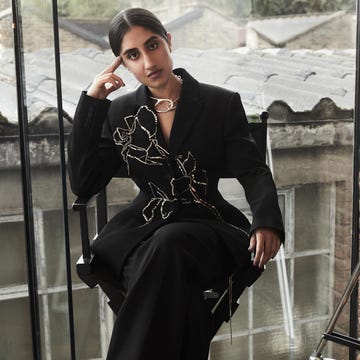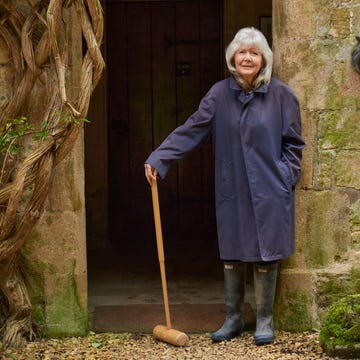Francesca Amfitheatrof is a disruptor. In just six years as the artistic director for watches and jewellery at Louis Vuitton, she has caused a seismic shift in this most rarified sector of the luxury market, sending shockwaves across Place Vendôme and throughout the heart of Paris. With an almost careless insouciance, the 56-year-old designer has turned centuries of tradition on its head, changing the way we buy and wear jewellery. An unwavering sense of adventure, an exhaustive creative process and – importantly – an unapologetically rebellious streak all contribute to her glittering success. “I can be brave here,” she says. “What we’re creating isn’t a reproduction of something that already exists. It’s brand new.”
Since she took up her role in 2018, Amfitheatrof has been bold in a business that’s more conservative than its fashion counterpart, signalling an ambitious new era for the world’s largest luxury house by pushing its savoir-faire and showcasing extraordinary stones. “I don’t think anyone saw us coming,” she says. “I mean, can you imagine Vuitton jewellery? Nobody would have thought that it could be something of value. I think that, very quickly, we have shown our competition that we have a recognisable language. What we’ve done is pretty phenomenal.”
The same could be said of Amfitheatrof herself. She was born in Tokyo, her late father was a bureau chief at Time, while her Italian mother worked as a PR for Valentino; she had a glamorous, nomadic childhood before settling at boarding school in England.
An art-foundation course was followed by a BA at Central Saint Martins, then onto the Royal College of Art, where she experimented with making jewellery. Her friends at the time included Alexander McQueen and Damien Hirst; another friend, Jay Jopling of White Cube, put on her first show of silverware, which was bought by Giorgio Armani and Karl Lagerfeld.
So far, so fabulous: she had a spell honing her craft in Italy (she’s a hands-on jeweller, able to mix her own gold) and then there was a series of roles, multidisciplinary projects and collaborations, each bigger than before: Marni, Balenciaga, Chanel, Asprey and Garrard. She was the head curator of the Gucci Museum from 2010 to 2013. “It’s quite good that I move around,” she says, “because I’m always brimming with ideas.” Even now, alongside annual high-jewellery and fine-jewellery collections for Louis Vuitton, she also acts as the head of creative for the century-old Venetian high-jewellery house Codognato. “I’m excited to get involved in a lot of different things,” she says. “I’m not the kind of artistic director that sits in her office.”
Amfitheatrof’s career found fresh focus in 2014 when she became design director of Tiffany & Co, the first woman to hold the post. Her hugely successful debut collection, Tiffany T, was launched a year after her arrival. In just four years at the brand, she also created the HardWear collection, controversially casting Lady Gaga in its ad campaign. “Each of my creative journeys at these houses has been unique,” she says. “Every single one of those experiences adds to the molecular change that happens inside you when you become somebody who can be in a leadership position.”
When Louis Vuitton approached her, offering the biggest job in the world of jewellery, Amfitheatrof didn’t think twice. “Somebody shows you a mountain and you either look at it and go, ‘Oh my god, I can’t do this,’ or you can’t wait to get to the top. I want that view from the top. It’s a better view.”
A spirit of adventure and exploration is at the heart of Louis Vuitton – founded in 1854 by a trunk-maker – and this suits Amfitheatrof perfectly. She lives with her investor husband Ben Curwin and teenage children Niko and Stella May in Connecticut, and flies to Paris for a week every month to meet with her team. The family also own a holiday home on the tiny Italian island of Ventotene, literally and almost unbelievably created inside a cave. “Vuitton is a company based on travel,” she says, “And I’m a born nomad. It’s also a company that really values creativity while giving you a lot of freedom. So if you’re someone with confidence and vision, it’s an amazing place to create.” She navigates the corporate environment by remembering wisdom once shared with her by Karl Lagerfeld: “He would advise, ‘Just say yes to everyone, then do exactly what you think you should be doing. Don’t bother arguing. Say yes and do what you want.’”
From the start, Amfitheatrof approached things with her usual sense of stylish informality. “High jewellery is often very ageing – it’s wearing you – but at Louis Vuitton we’re creating something that’s youthful,” she says. “Our jewellery tends to take more risks – there isn’t hundreds of years of tradition that means things are done only in a certain way. We’re able to move like a ready-to-wear house – I mean, our jewellery still takes years, but we’re creating it with a different kind of atmosphere.” That’s not to say it isn’t a serious business: Amfitheatrof has pushed the technical abilities of the Place Vendôme workshop, creating two unique diamond cuts, the star and the flower of the LV monogram. Given that the last real innovation here took place in the 18th century, when Louis XV of France commissioned a diamond in the form of his lover’s lips – later known as the marquise – it’s quite some achievement.
She’s a compelling storyteller, showcasing new launches in settings she art directs, often alongside museum-worthy pieces she has also curated – for the high-jewellery collection Deep Time. This included a slice of the 4.5-billion-year-old Imilac meteorite, sparkling with pale-green crystals that were formed at the birth of our solar system. “Jewellery is the only object that can have such a deep connection to the person, to memories, to places,” she says. For Amfitheatrof, it’s a sensory and emotional experience, which perhaps accounts for the way her work has achieved such extraordinary resonance. “As a woman wearing jewellery, I’m obsessive about how it feels on you,” she says. “Jewellery was about ownership in the past; it’s traditional because men have designed it. But jewellery sits on your skin; it’s part of your body. It’s integrated in you after a while, and so it needs to feel sensual. You’ve got to fall in love with it a little bit more every day.”
The December/January issue of Harper's Bazaar UK, celebrating our Women of the Year, is on newsstands now.















